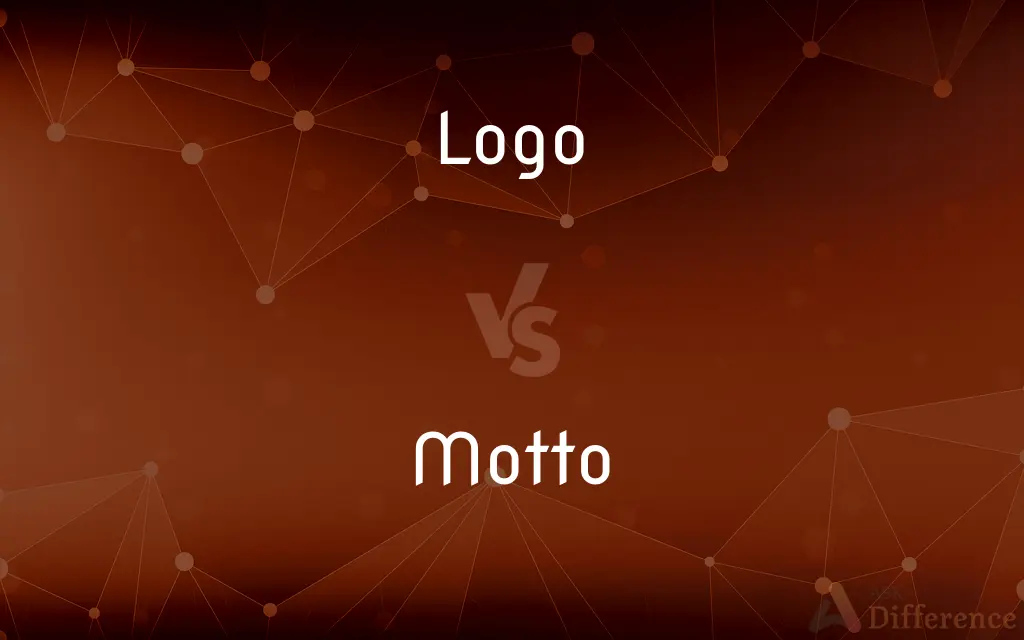Logo vs. Motto — What's the Difference?
Edited by Tayyaba Rehman — By Maham Liaqat — Updated on April 22, 2024
Logo represents a company visually with symbols or graphics, while a motto uses a short phrase to express guiding principles.

Difference Between Logo and Motto
Table of Contents
ADVERTISEMENT
Key Differences
A logo is a graphic mark or emblem used by organizations to aid and promote instant public recognition. Whereas a motto is a brief statement used to express a principle, goal, or ideal held by an organization or individual.
Logos are often designed to evoke specific feelings and associations with the brand without using words. On the other hand, mottos rely on the power of language to communicate a message or intention clearly and succinctly.
While logos are a visual representation and require design skills to create something unique and memorable, mottos depend on linguistic creativity and brevity to make an impact.
Whereas logos can undergo changes and redesigns as a company evolves, mottos tend to remain consistent over time, reinforcing the enduring values or mission of the brand.
Logos and mottos both play crucial roles in branding but serve different purposes; a logo is primarily seen and recognized, while a motto is read and reflected upon.
ADVERTISEMENT
Comparison Chart
Definition
A graphical mark or emblem used for public recognition.
A brief statement expressing a guiding principle.
Purpose
To visually identify a brand or organization.
To convey principles or intentions through words.
Components
Images, icons, symbols, or stylized text.
A concise phrase or sentence.
Variability
Can be redesigned to update brand image.
Usually remains consistent to maintain its message.
Impact
Recognized visually and can evoke emotions.
Communicated through language and provokes thought.
Compare with Definitions
Logo
A graphical emblem used on company materials.
Every piece of official stationery featured the company’s logo in the header.
Motto
A slogan or phrase associated with a group or individual.
The revolutionary's motto, Liberty or Death, became a rallying cry.
Logo
A branding element used in marketing.
The logo was prominently displayed at the event to reinforce brand visibility.
Motto
A maxim adopted as an expression of a guiding principle.
The school's motto, Learn and Grow, is displayed at the entrance.
Logo
A design used to distinguish a company from others.
The distinct logo helps consumers easily differentiate their products from competitors.
Motto
A catchphrase that communicates the essence of a collective ethos.
The company's motto, Customer First, drives all its service policies.
Logo
A symbol or small design adopted by an organization.
The company's logo, a red and blue circle, is instantly recognizable worldwide.
Motto
A short sentence or phrase expressing a rule guiding the behavior of others.
Their family motto, Honor and Truth, reflects their values.
Logo
A visual representation that signifies corporate identity.
Their new logo is a green leaf, symbolizing their commitment to environmental sustainability.
Motto
A principle expressed succinctly.
The environmental group’s motto is Think Globally, Act Locally.
Logo
A logo (abbreviation of logotype, from Greek: λόγος, romanized: logos, lit. 'word' and Greek: τύπος, romanized: typos, lit. 'imprint') is a graphic mark, emblem, or symbol used to aid and promote public identification and recognition. It may be of an abstract or figurative design or include the text of the name it represents as in a wordmark.
Motto
A motto (derived from the Latin muttum, 'mutter', by way of Italian motto, 'word', 'sentence') is the general motivation or intention of an individual, family, social group or organization. Mottos are usually found predominantly in written form (unlike slogans, which may also be expressed orally), and may stem from long traditions of social foundations, or from significant events, such as a civil war or a revolution.
Logo
A symbol or other small design adopted by an organization to identify its products, uniform, vehicles, etc.
The Olympic logo was emblazoned across the tracksuits
Motto
A short sentence or phrase chosen as encapsulating the beliefs or ideals of an individual, family, or institution
The family motto is ‘Faithful though Unfortunate’
Logo
A symbol or design that identifies a brand.
Motto
A phrase which recurs throughout a musical work and has some symbolical significance
They were developing the use of leitmotifs or mottoes that appear throughout an opera
Logo
A visual symbol or emblem that acts as a trademark or a means of identification of a company or organization.
Motto
A brief statement used to express a principle, goal, or ideal
“We explain that when someone is cruel, or acts like a bully, you don't stoop to their level—no, our motto is ‘when they go low, we go high'” (Michelle Obama).
Logo
(by extension) An audio recording for the same purpose; a jingle.
Motto
(heraldry) A sentence, phrase, or word, forming part of an heraldic achievement.
Logo
(science) A single graphic which contains one or more separate elements.
Motto
A sentence, phrase, or word, prefixed to an essay, discourse, chapter, canto, or the like, suggestive of its subject matter; a short, suggestive expression of a guiding principle; a maxim.
Logo
An ensign, a badge of office, rank, or power.
Motto
(obsolete) A paper packet containing a sweetmeat, cracker, etc., together with a scrap of paper bearing a motto.
Logo
A company emblem or device
Motto
(intransitive) To compose mottos.
Motto
A sentence, phrase, or word, forming part of an heraldic achievment.
Motto
A sentence, phrase, or word, prefixed to an essay, discourse, chapter, canto, or the like, suggestive of its subject matter; a short, suggestive expression of a guiding principle; a maxim.
It was the motto of a bishop eminent for his piety and good works, . . . "Serve God, and be cheerful."
Motto
A favorite saying of a sect or political group
Common Curiosities
How is a motto used differently from a logo?
A motto conveys a guiding principle or goal through words, whereas a logo provides visual brand recognition.
Can a logo contain text?
Yes, logos can contain text, usually stylized or as part of a symbol.
How can a motto affect public perception?
A motto can significantly impact public perception by clearly stating what an organization stands for, thereby shaping its image.
Why do mottos tend to remain consistent over time?
Mottos remain consistent to continue conveying the same values or principles as they represent foundational beliefs.
What is the primary function of a logo?
A logo primarily functions as a visual identifier for brands and organizations.
Are logos only used by commercial entities?
No, logos are used by various organizations, including non-profits, educational institutions, and governments.
Can a motto change as an organization evolves?
While mottos can change, they typically do so less frequently, as they are tied closely to the enduring values of the organization.
What considerations should be taken when crafting a motto?
Considerations should include clarity, brevity, and the profound conveyance of the organization's foundational beliefs.
How does a logo contribute to brand identity?
A logo contributes by providing a unique and recognizable visual symbol that represents the brand across various mediums.
Is it necessary for all organizations to have both a logo and a motto?
It's not necessary, but having both can strengthen an organization's branding and communication strategy.
What is the importance of a motto within a company or organization?
A motto is important as it succinctly expresses the core beliefs or intentions of an organization, serving as a constant reminder to its members and the public.
What are some challenges in designing an effective logo?
Challenges include creating a unique design that is simple yet memorable, and that communicates the essence of the brand.
In what ways can a motto be communicated to the public?
A motto can be communicated through marketing materials, public statements, signage, and company literature.
How do cultural differences influence logo design?
Cultural differences can greatly influence logo design in terms of symbols, colors, and elements that resonate with local audiences.
How do logos and mottos interact in a branding strategy?
Logos and mottos interact by visually and verbally articulating a brand's identity, often complementing each other in marketing and communications.
Share Your Discovery

Previous Comparison
Tangy vs. Tart
Next Comparison
Booklet vs. HandoutAuthor Spotlight
Written by
Maham LiaqatEdited by
Tayyaba RehmanTayyaba Rehman is a distinguished writer, currently serving as a primary contributor to askdifference.com. As a researcher in semantics and etymology, Tayyaba's passion for the complexity of languages and their distinctions has found a perfect home on the platform. Tayyaba delves into the intricacies of language, distinguishing between commonly confused words and phrases, thereby providing clarity for readers worldwide.














































